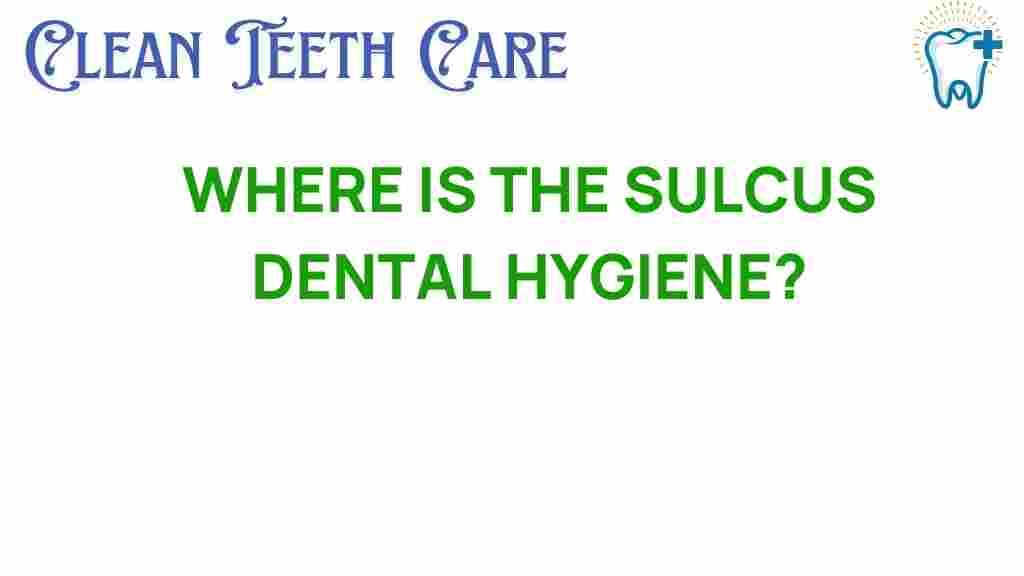Unveiling the Mystery: What Is the Sulcus in Dental Hygiene?
When it comes to maintaining optimal oral health, understanding the various components of dental anatomy is crucial. One important aspect that often flies under the radar is the sulcus. This article will delve into the significance of the sulcus in the context of dental hygiene, gum health, and overall periodontal care. We will explore what the sulcus is, its role in oral health, how it relates to plaque buildup, and the best practices for maintaining a healthy sulcus.
What is the Sulcus?
The term “sulcus” refers to the small groove or space between the gum and the tooth. In dental anatomy, this area is known as the gingival sulcus. It plays a critical role in periodontal health as it acts as a barrier against bacteria and plaque buildup. The depth of the sulcus is a vital indicator of gum health; a healthy sulcus typically measures between 1 to 3 millimeters.
The Importance of Sulcus in Dental Hygiene
The sulcus is more than just a space; it serves as a protective mechanism for your teeth and gums. Here are several reasons why it is essential to maintain the health of the sulcus:
- Barrier Against Bacteria: The sulcus helps keep harmful bacteria at bay, preventing them from entering the deeper tissues of the gums.
- Indicator of Gum Health: Dentists often measure the depth of the sulcus during check-ups to assess periodontal health. A deepening sulcus can indicate gum disease.
- Role in Plaque Management: Regular cleaning and care of the sulcus help control plaque accumulation, which is crucial for preventing cavities and gum disease.
Understanding Gum Health and Periodontal Care
Maintaining healthy gums is vital for overall oral health. The sulcus plays a significant role in this regard. The following points highlight the connection between the sulcus, gum health, and periodontal care:
- Healthy Sulcus: A shallow sulcus indicates good gum health, while a deeper sulcus often suggests inflammation or disease.
- Regular Dental Check-Ups: Routine visits to the dentist can help monitor the health of your sulcus and gums.
- Preventive Care: Good oral hygiene practices, including brushing and flossing, can help prevent plaque buildup and maintain a healthy sulcus.
How to Maintain a Healthy Sulcus
Maintaining a healthy sulcus is essential for preventing periodontal disease and ensuring good gum health. Here’s a step-by-step guide to help you achieve this:
1. Regular Brushing
Brush your teeth at least twice a day with fluoride toothpaste. Pay attention to the gum line, as this is where plaque tends to accumulate.
2. Floss Daily
Flossing helps remove food particles and plaque from between your teeth and below the gum line, promoting a healthy sulcus.
3. Use Mouthwash
Antimicrobial mouthwashes can help reduce bacteria in the mouth, contributing to a healthier sulcus and better gum health.
4. Regular Dental Visits
Schedule dental check-ups at least twice a year for professional cleanings and assessments of your gum health. Your dentist can measure the depth of your sulcus and identify any potential issues early on.
Dealing with Plaque Buildup
Plaque buildup in the sulcus can lead to serious gum issues if not addressed promptly. Here are some troubleshooting tips:
- Identify Warning Signs: Look out for symptoms such as swollen gums, bleeding while brushing or flossing, and persistent bad breath.
- Increase Oral Hygiene Efforts: If plaque buildup is detected, increase the frequency of brushing and flossing.
- Consider Professional Cleaning: Don’t hesitate to consult your dentist for a professional cleaning if you notice increased plaque or tartar.
Common Myths About the Sulcus and Gum Health
There are several myths surrounding the sulcus and dental hygiene that can lead to misunderstandings about gum health:
- Myth 1: Flossing is not necessary if I brush my teeth well.
Fact: Flossing is essential for cleaning areas that a toothbrush cannot reach, including the sulcus. - Myth 2: Gum disease only affects older adults.
Fact: Gum disease can affect anyone, regardless of age, especially if proper oral hygiene is neglected. - Myth 3: If my gums don’t bleed, they are healthy.
Fact: Healthy gums should not bleed; however, the absence of bleeding does not always indicate overall health.
Conclusion
The sulcus is a vital component of dental hygiene and plays a significant role in maintaining gum health and preventing periodontal disease. Understanding its function and how to care for it can help you achieve optimal oral health. By incorporating good dental hygiene practices such as regular brushing, flossing, and professional dental visits, you can keep your sulcus healthy and reduce the risk of plaque buildup and gum issues.
For more information about dental hygiene and maintaining good oral health, be sure to check out this helpful resource. You can also consult your dentist for personalized advice on periodontal care and maintaining a healthy sulcus.
This article is in the category Hygiene and created by CleanTeethCare Team
